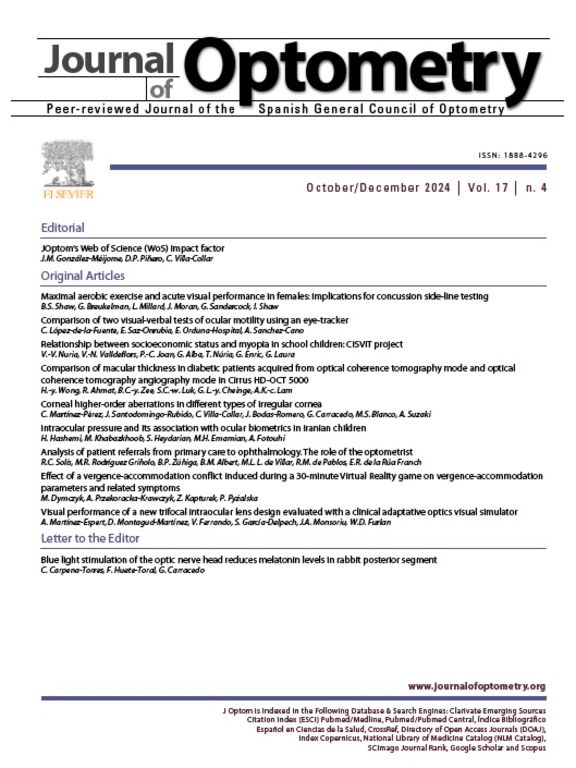Eyelid imbrication syndrome is an idiopathic acquired eyelid disorder characterized by upper eyelids overriding the lower eyelids. Congenital eyelid imbrications syndrome is extremely rare and thorough review of literature revealed only two previously reported cases and one congenital combined eyelid imbrications and floppy eyelid syndrome. We report a third case of bilateral asymmetric congenital eyelid imbrication syndrome and a second case of congenital combined eyelid imbrication and floppy eyelid syndrome that resolved with conservative treatment.
El síndrome de imbricación del párpado es un proceso adquirido idiopático, caracterizado por el acabalgamiento del párpado superior sobre el inferior. El síndrome congénito es excepcional y, a través de una revisión de los estudios publicados, sólo identificamos dos casos descritos previamente y un síndrome combinado congénito de imbricación y párpado laxo. Describimos un tercer caso de síndrome congénito de imbricación asimétrica, bilateral del párpado y un segundo caso de síndrome combinado congénito de imbricación y párpado laxo, que se resolvieron con tratamiento conservador.
Eyelid imbrication syndrome, which is characterized by upper eyelids overriding the lower eyelids, is an idiopathic acquired eyelid disorder usually seen in patients with floppy eyelid syndrome or in patients who underwent lower eyelid lateral tarsal strip procedure for eyelid laxity.1 It is usually under-recognized cause of chronic papillary conjunctivitis in adult as a result of the mechanical rubbing of the conjunctiva against the lower eyelid margin and eyelashes.2 In adult, the definitive treatment of eyelid imbrication is upper eyelid tightening procedure.3 Congenital eyelid imbrications syndrome is extremely rare and thorough review of literature revealed only two previously reported cases4,5 and one congenital combined eyelid imbrications and floppy eyelid syndrome.5 We report a third case of bilateral asymmetric congenital eyelid imbrication syndrome and a second case of congenital combined eyelid imbrication and floppy eyelid syndrome that resolved with conservative treatment.
Case reportA full- term newborn Jordanian male, after a normal unassisted vaginal delivery, was referred in the second day postpartum for treatment of eye discharge and abnormal overlapping of the eyelids that was seen immediately after delivery. The mother had regular ante- natal care and smooth pregnancy and she had neither history of chronic systemic illnesses nor drug intake during pregnancy. Family history revealed negative consanguinity and there was no previous similar eyelid imbrication anomaly.
Ocular examination showed bilateral and asymmetric elongated upper eyelids overlapping the lower lid margins while the child asleep. The eyelashes of the right lower eyelid were completely covered by the upper eyelid while the left upper eyelid is covering about 1 to 2 millimeters of the lower eyelashes (Figure 1). The canthal tendons of both upper eyelids were laxed and the right upper eyelid had tendency for spontaneous eversion on crying and yawing (Figure 2). The skin of the lower eyelids was contaminated with purulent discharge. Tarsal conjunctiva of both upper eyelids showed minimal hyperemia. Both corneas were clear and showed no fluorescein staining. The anterior and posterior segments and extra-ocular motility were normal.
A 1-day old child with bilateral asymmetric congenital imbrication syndrome. The upper eyelids overlap the lower eyelids on eye closure. The eyelashes of the right lower eyelid are completely covered by the upper eyelid while the left upper eyelid is covering about 1 to 2 millimeters of the lower eyelashes.
The patient was treated with topical antibiotics and eye lubrication and scheduled for regular follow up. After 3 weeks the eyelids were found to be in the normal position and there was no spontaneous eversion of the upper eyelids.
DiscussionCongenital eyelid imbrication syndrome is a rare condition, and the exact cause of which remains unknown.1 The condition was first reported by Rumelt et al.4 in 2004 who described a case of congenital eyelid imbrication syndrome in a healthy full-term girl with no other systemic associations that had a benign course. The second case was reported by De Silva et al.5 in 2006 in an otherwise healthy neonate presenting with overriding upper lids on eyelid closure and also spontaneous upper lid eversion on forceful contraction of orbicularis oculi. In our case the eyelids had spontaneously eversion on crying and yawing. Both previously described cases were symmetrical in both eyes while in our case the right side was more affected (Figure 1). As there was no history of mechanical stimuli we could not find an explanation in this one-day old child why the right eyelid was more affected than the left eyelid. Rao et al.6 described the first case of Floppy Eyelid Syndrome with easy eversion of lids present since birth in Down's syndrome. Rumelt et al.4 suggested that the longer and less stretched canthal tendons were the attributing factor, and gradual tightening, possibly related to postnatal growth, may have resulted in its resolution.
In our case the patho-physiology of these combined congenital abnormalities is probably laxity of the lateral canthal tendons, which is similar to patho-physiology of Floppy Eyelid Syndrome in adult and congenital abnormality of the tarsi. Post-natal growth of the bony orbit may contribute to the spontaneous correction of the eyelid imbrications and floppy eyelid. All the cases had benign courses with spontaneous natural resolution with apparent tightening of the upper canthal tendons and this may explain why it is under-reported. Although congenital eyelid imbrication syndrome spontaneously resolves, early detection of this condition is very important to prevent serious complications like corneal epithelial defect and ulcer. It is also essential to mention that a floppy eyelid syndrome should be searched in all newborns with a congenital imbrication syndrome.
Conflict of interestThe authors state they have no conflict of interest.











